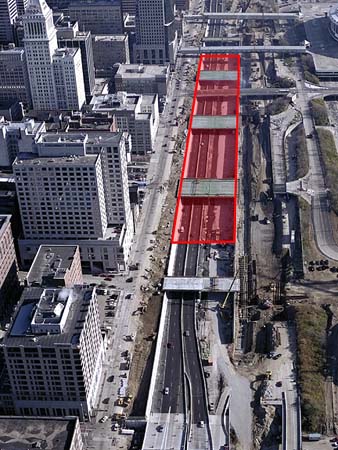
View of the center median piles, in March 2000.

Ft. Washington Way was originally built from 1959-1963. The mile long expressway was characterized by a mess of simultaneous right and left side entrance and exit ramps, short merges, poor signage, and a necessary aggressiveness by drivers. The idea for a deck over the old Ft. Washington Way trench had been tossed around for years, but with the significantly narrower trench promised by the 1998-2000 reconstruction the idea was much more practical. Due to a lack of funding the deck was left out of original reconstruction plans, however after construction was well underway in 1999 the idea was revived.
Funding for the pile driving was secured and actual
work
took place from Feb 2000 through August. Four decks of various sizes
between
originally planned overpasses will combine for a total tunnel length of
1200ft. 750 piles were driven, with 3 rows of 250 along the north edge,
south edge, and median between the eastbound and westbound lanes. The
cost
of the pile driving was $10 million and estimated cost of the future
supports
and actual decking is $46 million. $14 million was saved by driving the
piles before reconstruction was complete. The deck will not be built
until
at least 2005, when development south of the expressway is complete.
The
deck itself will be designated as a park, and so therefore will be
eligible
for funds from additional sources.

View of the center median piles, in March 2000.
The project is different from the nearby Lytle
Tunnel,
which was built for preservation purposes. This new tunnel is instead
intended
to eliminate the physical and psychological barrier that the eight lane
expressway
presents in order to improve nearby property values and encourage
development.